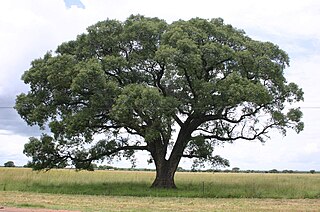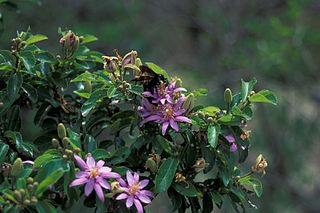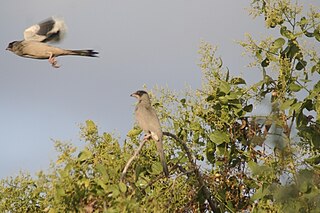
The Brassicales are an order of flowering plants, belonging to the eurosids II group of dicotyledons under the APG II system. One character common to many members of the order is the production of glucosinolate compounds. Most systems of classification have included this order, although sometimes under the name Capparales.

A toothbrush is an oral hygiene tool used to clean the teeth, gums, and tongue. It consists of a head of tightly clustered bristles, atop of which toothpaste can be applied, mounted on a handle which facilitates the cleaning of hard-to-reach areas of the mouth. They should be used in conjunction with something to clean between the teeth where the bristles of the toothbrush cannot reach - for example floss, tape or interdental brushes.

Sassafras is a genus of three extant and one extinct species of deciduous trees in the family Lauraceae, native to eastern North America and eastern Asia. The genus is distinguished by its aromatic properties, which have made the tree useful to humans.

Sclerocarya birrea, commonly known as the marula, is a medium-sized deciduous fruit-bearing tree, indigenous to the miombo woodlands of Southern Africa, the Sudano-Sahelian range of West Africa, the savanna woodlands of East Africa and Madagascar.

The miswak is a teeth-cleaning twig made from the Salvadora persica tree. The miswak's properties have been described thus: "Apart from their antibacterial activity which may help control the formation and activity of dental plaque, they can be used effectively as a natural toothbrush for teeth cleaning. Such sticks are effective, inexpensive, common, available, and contain many medical properties".

Salvadora oleoides is a small bushy evergreen tree found in India and Pakistan and southern Iran.

Colotis etrida, the little orange tip, is a species of butterfly in the family Pieridae. It is native to India, Sri Lanka and Pakistan.

Streblus asper is a tree known by several common names, including Siamese rough bush, khoi, serut, and toothbrush tree. It is a medium-sized tree native to dry regions in Indonesia, Cambodia, Thailand, India, Sri Lanka, Malaysia, and Vietnam.

Dalbergia sissoo, known commonly as North Indian rosewood or shisham, is a fast-growing, hardy, deciduous rosewood tree native to the Indian subcontinent and southern Iran. D. sissoo is a large, crooked tree with long, leathery leaves and whitish or pink flowers.

Oral hygiene is the practice of keeping one's oral cavity clean and free of disease and other problems by regular brushing of the teeth and adopting good hygiene habits. It is important that oral hygiene be carried out on a regular basis to enable prevention of dental disease and bad breath. The most common types of dental disease are tooth decay and gum diseases, including gingivitis, and periodontitis.

Salvadoraceae is a family in the plant order Brassicales, consisting of three genera with a total of 11 known species. They occur in Africa, Southeast Asia, and on Java, suggesting they are probably found in much of Malesia. They are often found in hot, dry areas.
Sarakan is the brand name for a range of oral health products owned by G.R Lane Health Products Ltd.

A teeth-cleaning twig is an oral hygiene tool made from a twig from a tree. It can help to prevent tooth decay and gum disease.

Grewia occidentalis, the crossberry, is a species of deciduous tree indigenous to Southern Africa.
Holistic dentistry, also called biological dentistry, biologic dentistry, alternative dentistry, unconventional dentistry, or biocompatible dentistry, is the equivalent of complementary and alternative medicine for dentistry. Although the holistic dental community is diverse in its practices and approaches, common threads include strong opposition to the use of amalgam in dental fillings, nonsurgical approaches to gum disease, and the belief that root canal treatments may endanger systemic health of the patient through the spread of trapped dental bacteria to the body. Many dentists who use these terms also regard water fluoridation unfavorably.

Meswak is a fluoride-free toothpaste brand that was launched in India by Balsara Hygiene in 1998. The toothpaste is marketed as a herbal toothpaste as it is made from extracts of the Salvadora persica plant. The teeth cleaning twig of the plant is reputed to have been used over 7,000 years ago.
Cassia sieberiana, the drumstick tree, is a tree in the family Fabaceae native to Africa. It ranges from 10 to 20 metres in height and has very bright yellow flowers. It is used for multiple medical purposes in Africa and is found in the secondary jungle of a forest.
Commiphora africana, commonly called African myrrh, is a small deciduous tree belonging to the Burseraceae, a family akin to the Anacardiaceae, occurring widely over sub-Saharan Africa in Angola, Botswana, Burkina Faso, Chad, Eswatini, Eritrea, Ethiopia, Kenya, Mali, Mauritania, Mozambique, Namibia, Niger, Senegal, Somalia, South Africa, Sudan, Tanzania, Uganda, Zambia and Zimbabwe. On sandy soils this species sometimes forms pure stands, deserving consideration as a plant community or association.

Pilu oil is an extract from seeds of the Pilu tree, also known as the toothbrush tree. It is used for soaps, detergents, and resist dyeing.



















